- Cucurbit downy mildew has been reported cucumber as far north as Maryland (Carolina Co.) on the Delmarva Peninsula. This is the first report of CDM in the region this growing season. All cucumber growers are encouraged to scout their fields on a regular basis. To track the progress of CDM in the US please visit the CDMpipe forecasting website here.
- There have been no reports of late blight in the region to date. Phytophthora nicotianae was reported on potato on the eastern shore of Virginia last week. Symptoms caused by P. nicotianae look similar to late blight. If you suspect late blight on potato or tomato please contact your county Extension office.
- The 2019 Fungicide Resistance Management Guide for Vegetable Crops in the mid-Atlantic Region is now available for FREE online.
- For more information on controlling these and other important diseases please see the 2019 Mid-Atlantic Commercial Vegetable Production Guide. The guide is available for FREE online by following the links on the Plant and Pest Advisory website. Hardcopies of the 2019 guide can be purchased through your local county Extension office.
Vegetable Crops Edition
Seasonal updates and alerts on insects, diseases, and weeds impacting vegetable crops. New Jersey Commercial Vegetable Production Recommendations updates between annual publication issues are included.
Subscriptions are available via EMAIL and RSS.
Quick Links:
 NJ Commercial Vegetable Production Recommendations
NJ Commercial Vegetable Production Recommendations
 Rutgers Weather Forecasting - Meteorological Information important to commercial agriculture.
Rutgers Weather Forecasting - Meteorological Information important to commercial agriculture.
Vegetable Disease Update – 7/1/19
IPM Update 6/26/19
Sweet Corn
The first European corn borer (ECB) flight is over, and no map will appear in this edition. Feeding percentages are now declining as affected plantings get treated and pass to the silk stage. No new feeding should occur until the second flight arrives.
Growers should continue to scout whorl and pre-tassel stage plantings weekly and consider treating when infested plants exceed 12% in a 50 plant sample. As plantings proceed to the pre-tassel stage, ECB larvae may be found in emerging tassels. It is a good idea to treat individual plantings as they move into the full tassel/first silk stage one time. This eliminates any ECB larvae that have emerged with the tassels as they begin to move down the stalk to re-enter near developing ears.
Useful insecticides for this particular application include synthetic pyrethroids (IRAC Grp 3), spinosyns (including OMRI approved Entrust) IRAC Grp 5), and diamides such as Coragen (IRAC Grp 28) or materials such as Besiege which include the active ingredient in Coragen. Synthetic pyrethroids alone should NOT be used for corn earworm (CEW) protection on silking corn. Control with these materials is very inconsistent.
The highest nightly trap catches of ECB for the week ending 6/26/19 are as follows:
| Cedarville 1 |
| Denville 1 |
| Hillsborough 1 |
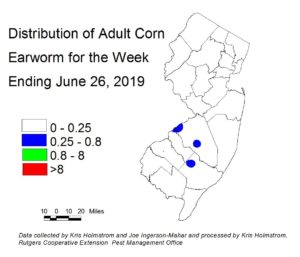 Corn earworm (CEW) moth catches in both trap types have decline dramatically over the past week (see blacklight map at left, and pheromone trap map below at right). We are entering the time of the season when CEW activity is at its’ lowest. Despite this, low numbers continue in southern NJ blacklights and in the much more sensitive pheromone traps. The overwhelming majority of activity is below Mercer County, with only scattered individuals in northern areas. Green areas on the pheromone trap map indicates a 4-5 day silk spray schedule. Blue areas represent a 5-6 day schedule, and white areas are 6-7 day. There
Corn earworm (CEW) moth catches in both trap types have decline dramatically over the past week (see blacklight map at left, and pheromone trap map below at right). We are entering the time of the season when CEW activity is at its’ lowest. Despite this, low numbers continue in southern NJ blacklights and in the much more sensitive pheromone traps. The overwhelming majority of activity is below Mercer County, with only scattered individuals in northern areas. Green areas on the pheromone trap map indicates a 4-5 day silk spray schedule. Blue areas represent a 5-6 day schedule, and white areas are 6-7 day. There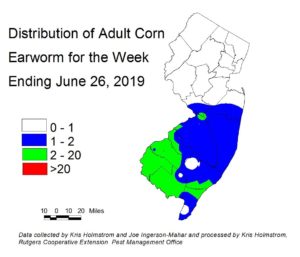 are far fewer CEW pheromone traps than blacklights, and the resulting map has much broader color bands as a result. It should also be noted that the pheromone traps are much more sensitive than blacklights. Therefore, the number of moths caught in pheromone traps required to generate a specific spray interval is much higher than the number caught in blacklight traps. It must be stressed that there is high variability in these catches, and growers should consult with their IPM practitioner on recommended spray schedules.
are far fewer CEW pheromone traps than blacklights, and the resulting map has much broader color bands as a result. It should also be noted that the pheromone traps are much more sensitive than blacklights. Therefore, the number of moths caught in pheromone traps required to generate a specific spray interval is much higher than the number caught in blacklight traps. It must be stressed that there is high variability in these catches, and growers should consult with their IPM practitioner on recommended spray schedules.
IPM Update 6/19/19
Sweet Corn
European corn borer (ECB) moths catches have declined to very low levels over the past week and no map will appear in this edition. The first flight is complete. Feeding percentages have stabilized, and no new feeding should occur until the second flight arrives.
Growers should continue to scout whorl and pre-tassel stage plantings weekly and consider treating when infested plants exceed 12% in a 50 plant sample. As plantings proceed to the pre-tassel stage, ECB larvae may be found in emerging tassels. It is a good idea to treat individual plantings as they move into the full tassel/first silk stage one time. This eliminates any ECB larvae that have emerged with the tassels as they begin to move down the stalk to re-enter near developing ears.
Useful insecticides for this particular application include synthetic pyrethroids (IRAC Grp 3), spinosyns (including OMRI approved Entrust) IRAC Grp 5), and diamides such as Coragen (IRAC Grp 28) or materials such as Besiege which include the active ingredient in Coragen. Synthetic pyrethroids alone should NOT be used for corn earworm (CEW) protection on silking corn. Control with these materials is very inconsistent.
The highest nightly trap catches of ECB for the week ending 6/19/19 are as follows:
| Crosswicks 1 | Milltown 1 |
| Milford 1 | South Branch 1 |
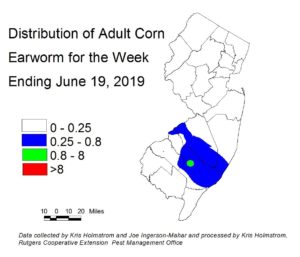 Scattered corn earworm (CEW) moths continue to be captured in southern NJ blacklight traps through early this week (see blacklight map at left) although these catches have declined since last week. Early plantings, now silking, are at risk of infestation from this pest.
Scattered corn earworm (CEW) moths continue to be captured in southern NJ blacklight traps through early this week (see blacklight map at left) although these catches have declined since last week. Early plantings, now silking, are at risk of infestation from this pest.
In the CEW pheromone trap network, catches have also declined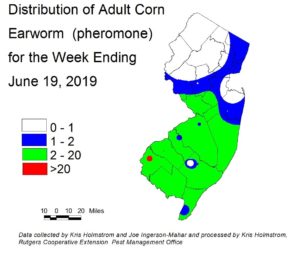 but remain highly variable, with higher numbers in the south, and very low activity in northern NJ (see pheromone map below at right). The green area on the pheromone trap map indicates a 4-5 day silk spray schedule. Blue areas represent a 5-6 day schedule, and white areas are 6-7 day. There are far fewer CEW pheromone traps than blacklights, and the resulting map has much broader color bands as a result. It should also be noted that the pheromone traps are much more sensitive than blacklights. Therefore, the number of moths caught in pheromone traps required to generate a specific spray interval is much higher than the number caught in blacklight traps. It must be stressed that there is high variability in these catches, and growers should consult with their IPM practitioner on recommended spray schedules.
but remain highly variable, with higher numbers in the south, and very low activity in northern NJ (see pheromone map below at right). The green area on the pheromone trap map indicates a 4-5 day silk spray schedule. Blue areas represent a 5-6 day schedule, and white areas are 6-7 day. There are far fewer CEW pheromone traps than blacklights, and the resulting map has much broader color bands as a result. It should also be noted that the pheromone traps are much more sensitive than blacklights. Therefore, the number of moths caught in pheromone traps required to generate a specific spray interval is much higher than the number caught in blacklight traps. It must be stressed that there is high variability in these catches, and growers should consult with their IPM practitioner on recommended spray schedules.
USDA Secretary Perdue Issues Statement on Disaster & Trade-Related Assistance
|
Basil downy mildew confirmed in southern New Jersey – ALERT 6/30/20
Basil downy mildew has been confirmed in field-grown basil and sweet basil being sold in ‘box store’ retail establishments in southern New Jersey. All basil growers are encouraged to scout their fields on a daily basis and begin preventative fungicide programs in BDM-susceptible and DMR varieties.
For more information on controlling BDM in the field-grown basil please click here.
For more information on controlling BDM in the greenhouse please click here.
To track the progress of BDM in the US please click here.
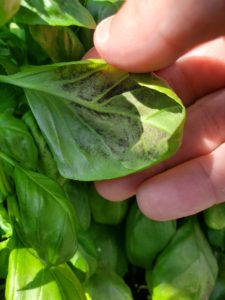
Basil downy mildew sporulating on the underside of an infected leaf.
IPM Update 6/12/19
Sweet Corn
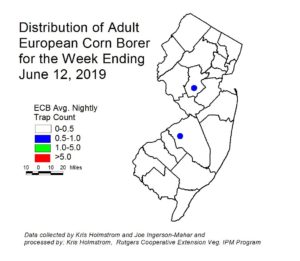 European corn borer (ECB) moths catches have declined to nearly nothing over the past week (see map at left). Feeding percentages have increased, and should peak over the next 5-7 days. As of the weekend, feeding percentages as high as 24% in Cape May and 60% were found in whorl corn in Somerset County, but these numbers seem to be outliers. The majority of feeding is in the 2-14% range throughout much of the state.
European corn borer (ECB) moths catches have declined to nearly nothing over the past week (see map at left). Feeding percentages have increased, and should peak over the next 5-7 days. As of the weekend, feeding percentages as high as 24% in Cape May and 60% were found in whorl corn in Somerset County, but these numbers seem to be outliers. The majority of feeding is in the 2-14% range throughout much of the state.
Growers should scout whorl and pre-tassel stage plantings weekly. Look for the characteristic “shot-hole” type of feeding (photo below at right) and consider treating when infested plants exceed 12% in a 50 plant sample. As plantings proceed to the pre-tassel stage, ECB larvae may be found in emerging tassels (see photo at left). It is a good idea to treat individual plantings as they move into the full tassel/first silk stage one time. This eliminates any ECB larvae that have emerged with the tassels as they begin to move down the stalk to re-enter near developing ears.
Useful insecticides for this particular application include synthetic  pyrethroids (IRAC Grp 3), spinosyns (including OMRI approved Entrust) IRAC Grp 5), and diamides such as Coragen (IRAC Grp 28) or materials such as Besiege which include the active ingredient in Coragen. Synthetic pyrethroids alone should NOT be used for corn earworm (CEW) protection on silking corn. Control with these materials is very inconsistent.
pyrethroids (IRAC Grp 3), spinosyns (including OMRI approved Entrust) IRAC Grp 5), and diamides such as Coragen (IRAC Grp 28) or materials such as Besiege which include the active ingredient in Coragen. Synthetic pyrethroids alone should NOT be used for corn earworm (CEW) protection on silking corn. Control with these materials is very inconsistent.
The highest nightly trap catches of ECB for the week ending 6/12/19 are as follows:
| Califon 1 | Milford 1 |
| Hillsborough 1 | Pedricktown 1 |
| Medford 1 | South Branch 1 |

